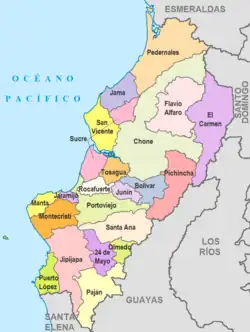Manabí Province
Manabí (Spanish pronunciation: [manaˈβi]) is a province in Ecuador. Its capital is Portoviejo. The province is named after the Manabí people.[3]
Manabí | |
|---|---|
Province | |
| Province of Manabí | |
 Flag  Coat of arms | |
| Anthem: Himno de Manabí | |
.svg.png.webp) Location of Manabí Province in Ecuador. | |
 Cantons of Manabí Province | |
| Coordinates: 1.05222°S 80.4506°W | |
| Country | Ecuador |
| Established | June 25, 1824. |
| Capital | Portoviejo |
| Cantons | List of Cantons |
| Area | |
| • Province | 18,939.60 km2 (7,312.62 sq mi) |
| Population (2010)[1] | |
| • Province | 1,369,780 |
| • Density | 72/km2 (190/sq mi) |
| • Urban | 615,491 |
| Time zone | UTC-5 (ECT) |
| Vehicle registration | M |
| HDI (2017) | 0.733[2] high · 10th |
| Website | www |

Demographics
Ethnic groups as of the Ecuadorian census of 2010:[4]
- Mestizo 66.7%
- Montubio 19.2%
- Afro-Ecuadorian 6.0%
- White 7.7%
- Indigenous 0.2%
- Other 0.3%
Economy
The economy of Manabí, a coastal province situated in the western region of the Republic of Ecuador, is deeply entrenched in the cultivation and processing of abundant natural resources and organic products. These commodities, which include but are not limited to cacao, bananas, noble woods, cotton, and seafood, have played a pivotal role in shaping the economic landscape of this region, and continue to serve as primary drivers of its economic growth and sustenance.
Moreover, the industrial sector of Manabí province is founded on the production of tuna, a marine delicacy renowned for its premium quality and taste, as well as the artisanal crafting of superior grade tobacco products, and the manufacturing of agua ardiente, a Spanish brandy beverage that is a hallmark of the region's culinary tradition and heritage.
In addition to these commercial activities, Manabí province is also renowned for its indigenous arts and crafts, particularly the crafting of Montecristi hats, popularly known as Panama hats, which are renowned for their stylish designs and intricate handiwork. The province is also recognized for its superior quality furniture made from rattan, a natural product that is widely renowned for its durability and aesthetic appeal.
In sum, the economy of Manabí province is a vibrant and diverse microcosm of the rich cultural and natural resources that abound in this region, and serves as a testament to the ingenuity and resourcefulness of its people.
Cantons
The province is divided into 22 cantons. The following table provides a comprehensive overview of the twenty-two cantons of Manabí province, including their respective populations at the 2001 census, their areas in square kilometers (km²), and the names of their respective canton seats or capitals:
| Canton | Pop. (2001) | Area (km²) | Seat/Capital |
|---|---|---|---|
| Bolívar | 35,627 | 537 | Calceta |
| Chone | 117,634 | 3,017 | Chone |
| El Carmen | 69,998 | 1,732 | El Carmen |
| Flavio Alfaro | 25,390 | 1,343 | Flavio Alfaro |
| Jama | 20,230 | 575 | Jama |
| Jaramijó | 11,967 | 97 | Jaramijó |
| Jipijapa | 65,796 | 1,401 | Jipijapa |
| Junín | 18,491 | 246 | Junín |
| Manta | 192,322 | 309 | Manta |
| Montecristi | 43,400 | 734 | Montecristi |
| Olmedo | 9,243 | 253 | Olmedo |
| Paján | 35,952 | 1,079 | Paján |
| Pedernales | 46,876 | 1,932 | Pedernales |
| Pichincha | 29,945 | 1,067 | Pichincha |
| Portoviejo | 303,682 | 955 | Portoviejo |
| Puerto López | 16,626 | 420 | Puerto López |
| Rocafuerte | 29,321 | 280 | Rocafuerte |
| San Vicente | 19,116 | 718 | San Vicente |
| Santa Ana | 45,287 | 1,022 | Santa Ana |
| Sucre | 52,158 | 764 | Bahía de Caráquez |
| Tosagua | 33,922 | 377 | Tosagua |
| Veinticuatro de Mayo | 28,294 | 524 | Sucre |
See also
References
- INEC.gob.ec Archived 2011-02-01 at the Wayback Machine
- Villalba, Juan. "Human Development Index in Ecuador". Scribd (in Spanish). Retrieved 2019-02-05.
- Origen del Nombre de Manabí Archived 2006-02-17 at the Wayback Machine
- "Resultados".